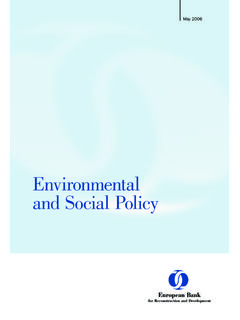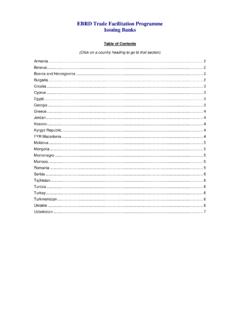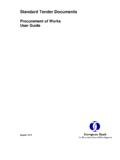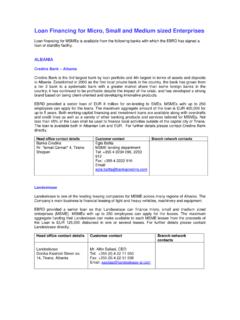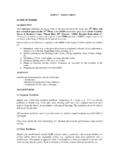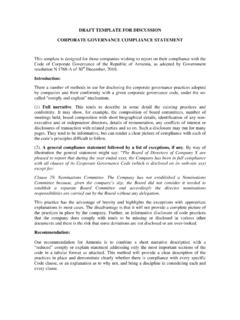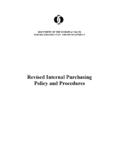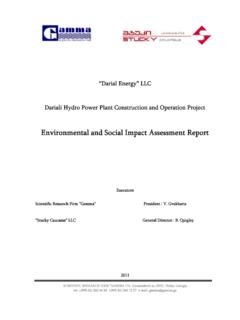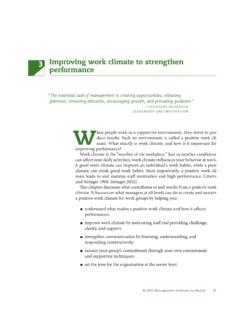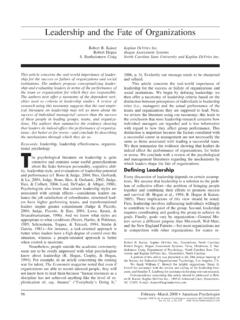Transcription of Capacity building in procurement - ebrd.com
1 Capacity building in procurementA sample assessment in the EBRD regionDecember 2012 AbbreviationsCACapacity AssessmentEBRDE uropean Bank of Reconstruction and DevelopmentIFII nternational Financing InstitutionLTTL egal Transition TeamMDBM ultilateral Development BankPEFAP ublic Expenditure and Financial AccountabilityRARisk AssessmentOECDO rganisation for Economic Co-operation and DevelopmentOLOperation LeaderPDProcurement DepartmentProcurement DepartmentThe procurement Department develops and updates procurement policies, rules and methods. It is also responsible for maintaining a procurement quality assurance system, reviewing complaints and publishing information about procurement opportunities and contract Introduction, objectives and background Foreword .. 1 Executive summary .. 3 Introduction .. 6 Objectives .. 8 Background of this study .. 91 procurement Capacity Introduction .. The role of Capacity assessment in the Bank.
2 Consistency of the instrument with good practices .. How to establish a meaningful dialogue with the client on Capacity building .. Assessment toolkit .. Gap analysis .. Action plan .. Example of suggested action plan .. Assessment is part of the Bank s due Sample of countries and projects .. 222 Risk in Introduction .. Risk in procurement : results .. Risk classifi cation .. Good practices observed .. Critical issues .. Simplicity and effectiveness .. Categories of the assessment .. 33 procurement Department3 Findings in implementing Legal framework .. Organisation .. Support and control Staffi Record keeping .. procurement planning .. procurement General assessment .. Project risks.
3 Comparison of results with the public procurement assessment .. Analysis ..514 Training activities followed Capacity assessment .. 535 Suppliers and contractors Business opportunities and industry outreach .. 555. Review of EvD activitieHeatingLvov-DistrictVik-Bij elinaCity-of-SkopjeBeolandUkrhydroenergo PUC-Cazin JAVYSKEGOCT oplana - NoviSad Lithuania-PostAktobe-DistrictRosmorportR ussian-RailwaysARAS ubotica-WaterDirectorate-Roads-SarajevoU krenergoElektroprivredaCity-of-TiranaSER AWT elekomFCNRSAIHCBGaz-SystemSrbij agasOSTC apacity building in procurementChapter 1 procurement Department 1It is my pleasure to present this report covering the results of the EBRD s three-year Capacity building in procurement Programme including the results of a sample assessment in the EBRD region. The assessment covers work conducted from 2010 to 2012 with the overall objective of assisting Clients in improving procurement performance by carrying out a Capacity Assessment (CA) on procurement , in partnership with selected Clients in the EBRD s countries of European Bank for Reconstruction and Development (EBRD) is an international fi nancial institution promoting transition to a market economy in its countries of Bank places special emphasis on institutional building in its countries of operations.
4 Public procurement occupies a central place within its overall objective of fostering effi cient use of public funds and contributes to institutional strengthening, corporate governance and Capacity institutional Capacity in procurement for the Bank s Clients is imperative for successful project implementation, the attainment of its objectives and for their sustainability. The Bank is therefore interested in strengthening the institutional Capacity of its Clients to administer procurement effectively and transparently and to provide training and assistance to the Clients, to ensure they have the necessary Capacity to effi ciently implement Bank fi nanced a major investor in the EBRD region, the Bank encourages international best practice in procurement to enable effi cient investment and thereby provide opportunities for successful its part, the EBRD aims to ensure that goods, works and services procured under Bank- fi nanced projects meet international best practice as refl ected in the Bank s procurement Policies and Rules which are aligned with the Government procurement Agreement of the World Trade addition.
5 The EBRD mission incorporates provision of technical assistance to its Clients to develop and Sound institutional Capacity in procurement for the Bank s Clients is imperative for successful project implementation, the attainment of its objectives and for their sustainability. Foreword2 Capacity building in procurementensure that basic procurement skills and procedures are in place for project implementation and to improve procurement performance. While designing and testing innovative and relevant analytical tools, for this Programme, the procurement Department noted that data analysed and processed in the review of Capacity was an invaluable asset for upstream Capacity building of the Client, turning the focus of the CA towards institutional building , reform and modernisation as a matter of good governance. Consequently, institutional Capacity assessment on procurement has become the road map for Clients achieving economical, effi cient and transparent procurement in a manner consistent with international best , international public procurement best practice calls for removing elements which reduce the effi ciency and economy of public procurement .
6 The Bank s response to this challenge has been to design a sustainable Capacity Assessment Programme including a practical Capacity Assessment Toolkit and Guide that is shared with Clients. This Capacity Assessment Toolkit has been empirically tested and fi ne-tuned with the participation of almost 30 selected Clients in 11 countries, in years 2010-2012. By and large, this Programme and its corresponding Toolkit focus on the Client s structure, organisation, resources and procurement practices of the institution but also takes into account the characteristics of the specifi c project. The fi nal outcome of this Programme has been a comprehensive determination of Clients' compliance in procurement against internationally accepted report is the result of an initiative by the Bank s procurement department that, between 2010 and 2012, implemented an intensive campaign to support procurement Capacity building activities. This push came under the Capacity building and Client Training Programme funded by the Bank s Shareholder Special Fund.
7 However, I would especially like to extend my gratitude to the EBRD countries of operations and Clients that volunteered to actively participate and thus improved our assessment quality and contributed to empirical real life results that constitute the overall value of this extraordinary professional contribution and commitment offered by offi cials, Client s experts and individuals refl ects the confi dence attributed to the EBRD as a partner in the transformation and transition in its countries of Jackholt, EBRDD irector of procurement DepartmentCapacity assessment on procurement has become the road map for Clients achieving economical, effi cient and transparent procurement in a manner consistent with international best practices. procurement Department 3 Three years ago, the European Bank for Reconstruction and Development (the EBRD or the Bank ) began to implement structured and standardised procurement Capacity assessments of its Clients in order to ensure that essential procurement skills and procedures were in place for the successful implementation of projects, and to improve overall procurement Programme was guided by the Bank s strategic objective to secure successful project implementation, recognising that sound institutional procurement Capacity of its Clients is central to achieve this these three years, the results from these assessments became an invaluable asset for Capacity building by way of applying the lessons to institutional reform and modernisation as a matter of good governance.
8 The Programme has successfully contributed to strengthening the Capacity of participant Clients to administer procurement effectively, economically and with increased in 2010, the Bank undertook two tasks regarding the assessment of Clients procurement Capacity : the fi rst was the EBRD Regional Public procurement Assessment. This assessment was conducted in 2010 with the overall objective of refl ecting the status of public procurement reform efforts in the countries of operations, as well as encouraging, infl uencing and providing guidance for ongoing reform of the public procurement sector. The second task was the Capacity assessment and Client training programme in public procurement . This report describes the fi ndings and recommendations of the latter collected in this report were the result of a joint effort by the Bank staff and the Bank-consultant summaryRisk distribution Source: E urostat and national authorities via CEIC : The chart shows unweighted averages for the transition region.
9 Low risk Medium low risk Medium high risk High riskPowerMunicipalTranspor tNSDT elecom 232136121121114 Capacity building in procurementThe Bank-consultant team produced 18 applications while the Bank-team applied the tool to nine additional the course of the three years, 27 individual reports prepared for operations teams recorded and assessed Client procurement activities in the region. These reports highlight implementation gaps in the procurement operations of fi ve sectors: Power and Energy, Municipal Infrastructure, Transport, Nuclear Safety and ICT (telecommunications). The assessments were collected through interviews and fi eldwork and later used to rate the procurement risk of the Bank s Clients in the sample were classifi ed in the higher risk group; fewer were classifi ed as moderately low risk; while one Client met practically all compliance standards, giving a unique opportunity to detail a low risk Client in the Bank s assessments also highlighted a large number of areas of opportunity for improvement within the region.
10 The contributing factors to these areas of opportunity are detailed in the main body of this report. The frequency of such areas of opportunity shows that there are several systemic issues in need of improvement, specifi cally elements of the legal framework, anti-corruption initiatives, organisational arrangements and support and control instruments. These are all elements in which the Bank can proactively infl uence the procurement function more overall objective of the Programme was to engage the Bank and selected Clients in a Capacity building effort in procurement . Secondary objectives included: providing the Bank with an expert toolkit to assess the Capacity of public sector Clients, to provide the Bank with a training package to further improve the dialogue with clients in areas of opportunity identifi ed in the assessment, and to provide the baseline of a Bank database about Clients strengths and opportunities in public procurement in the region.
